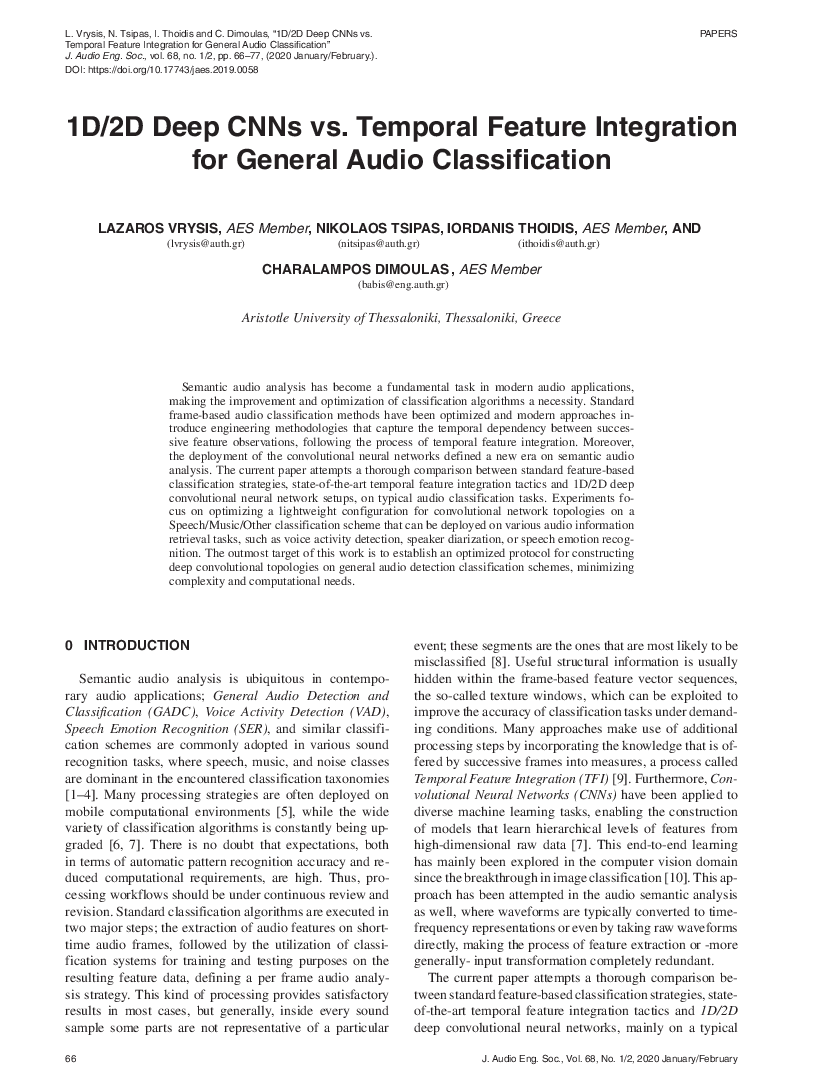Home / Publications / E-library page
You are currently logged in as an
Institutional Subscriber.
If you would like to logout,
please click on the button below.
Home / Publications / E-library page
Only AES members and Institutional Journal Subscribers can download
Semantic audio analysis has become a fundamental task in modern audio applications, making the improvement and optimization of classification algorithms a necessity. Standard frame-based audio classification methods have been optimized, and modern approaches introduce engineering methodologies that capture the temporal dependency between successive feature observations, following the process of temporal feature integration. Moreover, the deployment of the convolutional neural networks defined a new era on semantic audio analysis. This paper attempts a thorough comparison between standard feature-based classification strategies, state-of-the-art temporal feature integration tactics, and 1D/2D deep convolutional neural network setups on typical audio classification tasks. Experiments focus on optimizing a lightweight configuration for convolutional network topologies on a Speech/Music/Other classification scheme that can be deployed on various audio information retrieval tasks, such as voice activity detection, speaker diarization, or speech emotion recognition. The main target of this work is the establishment of an optimized protocol for constructing deep convolutional topologies on general audio detection classification schemes, minimizing complexity and computational needs.
Author (s): Vrysis, Lazaros; Tsipas, Nikolaos; Thoidis, Iordanis; Dimoulas, Charalampos
Affiliation:
Aristotle University of Thessaloniki, Thessaloniki, Greece
(See document for exact affiliation information.)
Publication Date:
2020-01-06
Import into BibTeX
Permalink: https://aes2.org/publications/elibrary-page/?id=20722
(985KB)
Click to purchase paper as a non-member or login as an AES member. If your company or school subscribes to the E-Library then switch to the institutional version. If you are not an AES member Join the AES. If you need to check your member status, login to the Member Portal.

Vrysis, Lazaros; Tsipas, Nikolaos; Thoidis, Iordanis; Dimoulas, Charalampos; 2020; 1D/2D Deep CNNs vs. Temporal Feature Integration for General Audio Classification [PDF]; Aristotle University of Thessaloniki, Thessaloniki, Greece; Paper ; Available from: https://aes2.org/publications/elibrary-page/?id=20722
Vrysis, Lazaros; Tsipas, Nikolaos; Thoidis, Iordanis; Dimoulas, Charalampos; 1D/2D Deep CNNs vs. Temporal Feature Integration for General Audio Classification [PDF]; Aristotle University of Thessaloniki, Thessaloniki, Greece; Paper ; 2020 Available: https://aes2.org/publications/elibrary-page/?id=20722
@article{vrysis20201d/2d,
author={vrysis lazaros and tsipas nikolaos and thoidis iordanis and dimoulas charalampos},
journal={journal of the audio engineering society},
title={1d/2d deep cnns vs. temporal feature integration for general audio classification},
year={2020},
volume={68},
issue={1/2},
pages={66-77},
month={january},}
TY – paper
TI – 1D/2D Deep CNNs vs. Temporal Feature Integration for General Audio Classification
SP – 66 EP – 77
AU – Vrysis, Lazaros
AU – Tsipas, Nikolaos
AU – Thoidis, Iordanis
AU – Dimoulas, Charalampos
PY – 2020
JO – Journal of the Audio Engineering Society
VO – 68
IS – 1/2
Y1 – January 2020